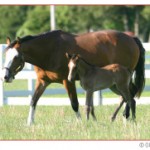 Now that the weather is finally warming up, we are spending more time with our horses, and are looking forward to even more enjoyable riding weather.
Now that the weather is finally warming up, we are spending more time with our horses, and are looking forward to even more enjoyable riding weather.
There are some nutritional concerns, however, during this season, and some management issues we should address to ensure the health and performance of our horses. For instance, the forage portion of many horses’ diets is changing from hay to fresh pasture, and this change can increase the risk of colic and/or laminitis for some horses. Horses that are kept on pasture year-round usually adjust to the new grass as it grows. Nature does a fairly good job of making pasture changes gradually. However, the risk of digestive disturbances such as colic and laminitis increases greatly when horses have been confined and fed a hay and grain diet during the winter, and are then abruptly turned out on the lush green pasture in the spring. Further, horses that have been kept up through the winter may overeat when turned out because of the palatability of the lush green foliage.
This sudden change in the diet may trigger digestive upset. There are several ways to prevent or minimize problems when introducing horses to spring pastures. Feeding hay immediately before turn-out may help keep horses from overeating, since they are less likely to overeat on an already full stomach. Restricting grazing time will also help minimize risks. A suggested schedule is: one hour or so of grazing once or twice a day on the first few days of grazing; then increase grazing time about an hour every two-three days until the horses are out full time, if that is the goal.
